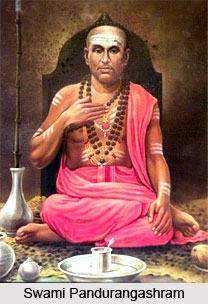 His Holiness Swami Pandurangashram was the 8th guru of the Chitrapur Saraswat Brahmin community and reigned from 1863 to 1915, for a period of 52 years. He succeeded his guru Swami Krishnashram, when he attained Maha Samadhi in the year 1857. Swami Pandurangashram was a Yogi, a Sanskrit scholar and an astrologer. He trained by Swami Raghunath Shastri and 8 Kashmiri scholars in the Sanskrit Scriptures. He brought about, many infrastructural improvements in Chitrapur Village in Shirali. During his administration Swami Pandurangashram turned Chitrapur into a model village, which included aspects of town-planning. Furthermore, the shrines of all the previous Gurus were restored and renovated. He believed in the concept of Dharma and brought several social changes. He also implemented a ban on overseas visits. In 1915, Swami Pandurangashram died and attained Maha Samadhi. His shrine is located at the Chitrapur Math in Shirali.
His Holiness Swami Pandurangashram was the 8th guru of the Chitrapur Saraswat Brahmin community and reigned from 1863 to 1915, for a period of 52 years. He succeeded his guru Swami Krishnashram, when he attained Maha Samadhi in the year 1857. Swami Pandurangashram was a Yogi, a Sanskrit scholar and an astrologer. He trained by Swami Raghunath Shastri and 8 Kashmiri scholars in the Sanskrit Scriptures. He brought about, many infrastructural improvements in Chitrapur Village in Shirali. During his administration Swami Pandurangashram turned Chitrapur into a model village, which included aspects of town-planning. Furthermore, the shrines of all the previous Gurus were restored and renovated. He believed in the concept of Dharma and brought several social changes. He also implemented a ban on overseas visits. In 1915, Swami Pandurangashram died and attained Maha Samadhi. His shrine is located at the Chitrapur Math in Shirali.
Early Life of Swami Pandurangashram
Swami Pandurangashram was born on the 6th day of the month of Jyeshta in 1847, to Nagar Shantapayya and his wife. He was named Nagar Kalappa. From a very tender age, he had enlisted among the students of the Chitrapur Math. This bright, intelligent and handsome young boy with his quick perception, superior intelligence and strong willed nature became a favourite with the incumbent head of the community, Swami Krishnashram. As the Shishya (disciple) at the tender age of 10, Swami Pandurangashram was ordained of the incumbent Mathadhipati (Head of the community) Swami Krishnashram in 1857. For 5 years he received guidance under the tutelage of his guru. On the 8th day of the month of Marghshirsha in 1863, after Swami Krishnashram attained Maha-Samadhi, He was officially crowned the Mathadhipati. His flair for administration was shown even as a shishya. He played an important role in the smooth execution of the first Rathotsav.
Social Reforms of Swami Pandurangashram
Swami Pandurangashram thus became the eighth guru of the Chitrapur Saraswat Brahmin community. For a period of 52 years from 1863 to 1915, the longest on record so far, he held the position. A Sanskrit scholar, a Yogi and a Jyothishi, Swami Pandurangashram was trained in the Sanskrit Scriptures under Swami Raghunath Shastri and also believed in Dharma which means the correct way to live one`s life.
Several infrastructural changes were brought about in Chitrapur Village in Shirali under the administration of Swami Pandurangashram. His planning was four folded: Reconstruction/Renovation of Samadhis, Planned construction of Chitrapur Village, Development of the Chitrapur Math and Renovation of Temples and mathas(Monasteries). With aspects of town-planning, Chitrapur village was made as a Model Village. From the main road up to the entrance of the Chitrapur Math, a road was constructed which had street lights on either sides. On the side of the roads Houses were built in files. Everyday the roads were swept clean. For the children, Schools were constructed.
The greater part of the Math, during his period, was rebuilt and all the Samadhis of His predecessors were reconstructed with Tamrashashan. A big tank, Shiva-Ganga Sarovar near the Math was dug and Panchavati, a tall building on the Govardhan Hill was also constructed. The mathas (Monasteries) at Mallapur, Gokarn and Mangalore were in a bad state. Mathas were renovated under Swami`s supervision. His Holiness Swami Pandurangashram had also brought about many social changes in the community. He firmly believes in Dharma and reprimanded those who did not follow it. Behind this act of his, Swami reasoned that ultimately it was Dharma that could help one attain the ultimate aim of Moksha. He imposed a ban on foreign visits and excommunicated anyone who went abroad. As Swami believed that a man would expose to the temptations of other cultures with the foreign visits, which would blatantly oppose Dharma.
Later Life of Swami Pandurangashram
Many people have experienced that in dire distress His Holiness Swami Pandurangashram devotees would redress the problems they faced with his grace. As the devotees got anxious about the continuation of the Guru Parampara, asked him to accept a Shishya (disciple). To all their pleas, he remained silent. His Holiness Swami Pandurangashram was greatly upset by the noncompliance of community members under his reign: The people were few in number, who firmly respected the Dharma and maintained the tradition of the ancestors.
His Holiness Swami Pandurangashram always prayed to Lord Bhavanishankar (the community deity) to give him strength to hold firm in his decision. In 1915, Swami made a decision to accept a Shishya, in the month of Vaisakha around time of June. Shantamoorthy, the son of a priest named Haridas Ramchandra Bhat was the one chosen by the divine will. During the Shishya Sweekar ceremony, a ceremony where the guru accepts his disciple, he was ordained as Anandashram.
Death of Swami Pandurangashram
Eight days after the Shishya Sweekar of Anandashram, Swami Pandurangashram`s health deteriorated. On 2nd day of the month of Jyeshtha, His Holiness Swami Pandurangashram attained Maha-Samadhi. He died at the age of 68. Inside the Chitrapur Math premises his Samadhi (Shrine) is located, to the left to the Samadhi of Swami Shankarashram I.









